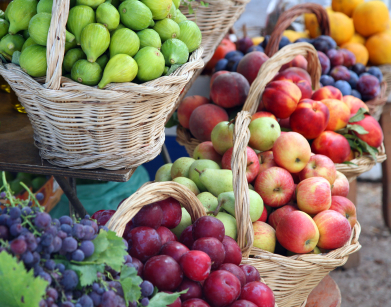Nothing is more important to your health than choosing safe and healthy foods to eat, especially if you are a pregnant woman or small child. Before and after birth, babies are much more vulnerable to dangerous chemicals found in pesticides, fertilizers, antibiotics and food additives. Babies’ bodies are still in the process of developing, and their immune systems, blood-brain barriers and liver detoxification enzymes aren’t as capable of dealing with toxic substances as an adult’s body.
Eating Healthy
The healthiest diet for you and your children is one composed of whole, organic foods such as fruits, vegetables, dairy, meat and whole grains. Packaged, processed foods aren’t nearly as nutritious as whole foods, are typically full of additives, and are often packaged in dangerous plastics. Even those processed foods labeled as “organic” can still be full of sugar and fat.
What Does “Organic” Mean?
“Organic” refers to a way of producing crops and livestock that involves using natural rather than artificial and chemical methods of farming. Organic crops are grown without the use of chemical herbicides, pesticides and fertilizers, and organic livestock are raised without the use of artificial antibiotics and/or growth hormones. Furthermore, crops and livestock cannot be genetically modified, cloned, or irradiated. These practices are not only friendlier to the environment and to the livestock, but they are healthier and safer for human consumption. Fewer toxic chemicals are entering the earth and our bodies.
Many people argue that organic foods taste better than their non-organic counterparts. And research suggests that organic foods tend to have more vitamins and minerals than conventional foods. One study found that organic foods average a 25% higher nutrient level (The Organic Center, Foster, Rhode Island). Further studies at the University of California at Davis have produced similar findings but have concluded that the nutritional benefit does not necessarily apply to all types of foods (for example, organic bell peppers are not more nutritious than conventional ones but significant differences were found between conventional and organic tomatoes).
Navigating Organic Labels
In 2002, the U.S. Department of Agriculture created a certification process for organic foods:
- When at least 95% of the ingredients are organic, the food can carry the USDA green and white organic seal. The remaining ingredients must come from the USDA’s list of allowable ingredients.
- When a food’s packaging claims it is “made with organic ingredients,” this means that at least 70% of the ingredients are organic, but the package cannot carry the USDA seal.
- A food can only claim to be “100% organic” if it only contains organic ingredients and nothing else.
Organic Produce
If you want to have a toxin-free diet, the most important change you can make it to buy organic fruits and vegetables. However, finding organic produce isn’t always easy, so it is important to know which foods are the worst offenders. On its website, the Environmental Working Group ranks produce based on its pesticide load. This Shopper’s Guide to Pesticides is also available as an iPhone app and as a PDF.
Try to always buy organic when dealing with produce that has the highest pesticide load. If buying all organic is too much for your budget, you can get away with conventional options for produce that has the lowest pesticide load. If you do buy conventional produce, the best way to remove pesticides and dirt from fruits and vegetables is to spray them with a mixture of 3 parts water to one part white vinegar and then rinse with water. This vinegar/water mixture will remove pesticides and approximately 98% of bacteria from the outer part of the produce. However, cleansing produce cannot get rid of any pesticides that may have been absorbed into the food so organic is still the best bet.
Choosing the Healthiest Meat
If you thought finding organic produce was hard, it is even more difficult to find the most natural and healthiest meat. Your best option is to choose free-range, grass-fed, organic meat. Not only is organic meat safer because it avoids the use of antibiotics, toxic pesticides and fertilizers in feed, but it is leaner and higher in omega-3 fatty acids. The best place to find this type of meat is from your local organic foods store or from local farms (see www.localharvest.org, www.farmfresh.org or eatwild.com for a list).
Choosing the Healthiest Fish
Fish are an excellent source of omega-3 fatty acids and other important nutrients. But mercury and other toxins can be found in certain fish, so it is important to choose carefully. If you are looking for sustainable fish that have been caught or farmed in environmentally friendly ways, check out the Seafood Watch Consumer Guide. For a list of the mercury loads in fish, go to the FDA’s list of mercury in fish. Pregnant and nursing women and young children are at a higher risk from mercury in fish and so should take certain precautions. The FDA recommends that pregnant and nursing women and young children should not eat shark, swordfish, king mackerel, or tilefish because they have the highest levels of mercury. They should not eat more than 12 ounces of fish that are lower in mercury (such as shrimp, canned light tuna, salmon, pollock and catfish). Be cautious about eating fish caught in local waters and check local advisories (visit http://www.epa.gov/waterscience/fish/states.htm).
Buy Local
It is also a good idea to buy local. By purchasing locally grown and raised foods, you are supporting local farms, the environment, your wallet and your health. And many local farms use organic farming methods that come close to organic standards. One option is to join a CSA (Community Supported Agriculture) farm. You can purchase a share in one of these farms and receive a box of locally grown (and often organic) fruits, vegetables, herbs, meat and eggs every week. See www.localharvest.org, www.eatwellguide.org, eatwild.com or www.farmfresh.org for a list of local and CSA farms near you. For a list of farms where you can pick your own fruits and veggies, visit www.pickyourown.org. For more information about getting farm-fresh products to your child’s school, visit www.farmtoschool.org.
Healthy Cooking and Food Storage
The way you store and cook food is important too. You may be tempted to store and microwave food in plastic containers, but you should try to avoid this as much as possible. Plastic tends to contain toxic chemicals which can leach into food over time or when heated (see discussion about Plastics). Instead, choose ceramic or glass containers for storage and heating. Stainless steel is great for water bottles and sippy cups. When preparing foods, try to avoid nonstick pots and pans, especially those that are damaged, because they can contain teflon (which contains perfluorcarbons) and aluminum (which has been linked to Alzheimer’s disease). Instead prepare your food in cookware made from stainless steel, ceramic, glass, porcelain, clay or cast-iron.
Eating Healthy on a Budget
Healthy eating doesn’t have to cost a lot of money. The Environmental Working Group has a shopping guide entitled Good Food on a Tight Budget. This guide is a great way to find healthy foods and save money.


